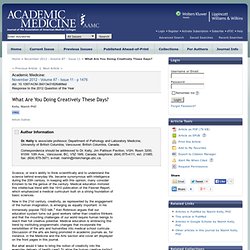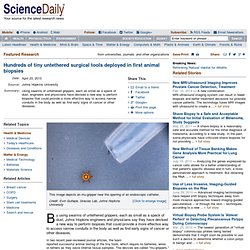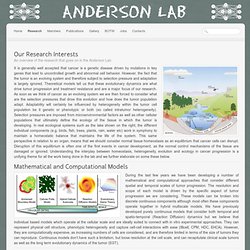

Can we stop the imaginectomies? TEDMED. Jacob Scott is a radiation oncologist and cancer theoretician who uses primary mathematical methods to develop novel and hopefully translatable biological hypotheses.

He came to this position in life by way of a tortuous career path that included astrophysics, nuclear engineering aboard a submarine, teaching physics and coaching wrestling at the high school level – all before beginning his doctorate in medicine. Dr. Scott began his scientific career studying astrophysics at the U.S. Naval Academy, where he graduated with a Bachelor of Science in Physics with merit. He went on to serve in the U.S. Medical education in the United States and Canada; a report to the Carnegie Foundation for the Advancement of Teaching : Flexner, Abraham, 1866-1959. American Medical Education 100 Years after the Flexner Report. What Are You Doing Creatively These Days? : Academic Medicine. Author Information Dr.

Kelly is associate professor, Department of Pathology and Laboratory Medicine, University of British Columbia, Vancouver, British Columbia, Canada. Correspondence should be addressed to Dr. Jack Andraka: A promising test for pancreatic cancer ... from a teenager. Hundreds of tiny untethered surgical tools deployed in first animal biopsies. By using swarms of untethered grippers, each as small as a speck of dust, Johns Hopkins engineers and physicians say they have devised a new way to perform biopsies that could provide a more effective way to access narrow conduits in the body as well as find early signs of cancer or other diseases.

In two recent peer-reviewed journal articles, the team reported successful animal testing of the tiny tools, which require no batteries, wires or tethers as they seize internal tissue samples. The devices are called "mu-grippers," incorporating the Greek letter that represents the term for "micro. " Instead of relying on electric or pneumatic power, these star-shaped tools are autonomously activated by the body's heat, which causes their tiny "fingers" to close on clusters of cells. Because the tools also contain a magnetic material, they can be retrieved through an existing body opening via a magnetic catheter. Research. An overview of the research that goes on in the Anderson Lab It is generally well accepted that cancer is a genetic disease driven by mutations in key genes that lead to uncontrolled growth and abnormal cell behavior.

However, the fact that the tumor is an evolving system and therefore subject to selection pressure and adaptation is largely ignored. Theoretical models tell us that these evolutionary dynamics are what drive tumor progression and treatment resistance and are a major focus of our research. As soon as we think of cancer as an evolving system we are then forced to consider what are the selection pressures that drive this evolution and how does the tumor population adapt. Adaptability will certainly be influenced by heterogeneity within the tumor cell population be it genetic or phenotypic or both (so called intratumor heterogeneity). What happens with a design thinking approach to healthcare? TEDMED.
You say you want a revolution? TEDMED. Talks. Innovation in Blood Centers on ADVANCE for Medical Laboratory Professionals. Mom's voice may improve the health of premature babies. When babies are born prematurely, they are thrust into a hospital environment that while highly successful at saving their lives, is not exactly the same as the mother's womb where ideal development occurs.

The Neonatal Intensive Care Unit (NICU) is equipped with highly skilled care givers and incubators that regulate temperature and humidity, but Amir Lahav, ScD, PhD, director of the Neonatal Research Lab at Brigham and Women's Hospital (BWH) thought that something was missing -- simulation of the maternal sounds that a baby would hear in the womb. The Art of Medicine. The health care system and its practitioners are under increasing pressure to provide efficient, effective, and consistent care to patients.

Patients want to be treated as an individual, not a case number; insurance companies want to pay the least amount of money possible for services; and physicians, nurses, pharmacists and other practitioners want to provide the best care they can. Today, these constraints limit the ability of the health care provider to provide creative, innovative care and, instead, marginalize patients to an algorithm to treat their symptoms. Now, more than ever, fostering creativity may be the best way to improve the health care system. The practice of medicine, and the rest of the health care disciplines, is deeply rooted in science. Rigorous medical education and training incorporates a didactic approach and an apprenticeship-type model of learning from experienced practitioners.
On inspiration and creativity in medicine - getting into medical school and then... Inspiration seems to be the theme of the month for me, so I thought I would share an inspirational moment with you.

Below is a 20 minute speech by Ken Robinson, who, as I learned recently, is one of the best speakers you will ever hear. Although he talks about education in general and its relation to creativity, this talk got me thinking about premedical and medical education. As we strive to achieve the highest GPAs, excel in every possible and impossible endeavor we undertake and maintain at least a semblance of human contact, many will take a safe path to success.
We will take courses we know will yield us the highest return for our investment. We will choose to study instead of seeing are friends. Another interesting point is most medical schools have rigorous structure in the curriculum. Preserving Creativity in Medicine. Centre for Medical Humanities : Imagination and Creativity. PASTEUR.